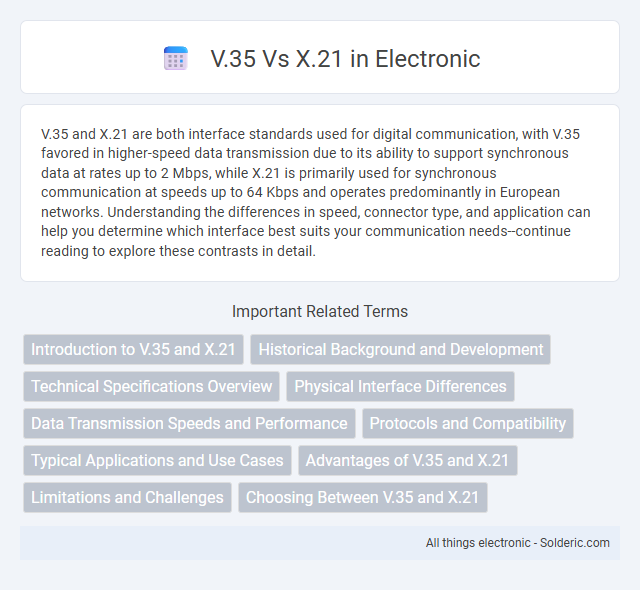V.35 and X.21 are both interface standards used for digital communication, with V.35 favored in higher-speed data transmission due to its ability to support synchronous data at rates up to 2 Mbps, while X.21 is primarily used for synchronous communication at speeds up to 64 Kbps and operates predominantly in European networks. Understanding the differences in speed, connector type, and application can help you determine which interface best suits your communication needs--continue reading to explore these contrasts in detail.
Comparison Table
| Feature | V.35 | X.21 |
|---|---|---|
| Standard Type | ITU-T V.35 | ITU-T X.21 |
| Usage | High-speed synchronous data transmission | Digital signaling for synchronous data transmission |
| Data Rate | Up to 2 Mbps | Up to 2 Mbps |
| Signal Type | Balanced differential signaling | Balanced differential signaling |
| Physical Connector | 34-pin D-sub (male) | 15-pin D-sub (female) |
| Interface Type | Serial interface | Serial interface |
| Line Encoding | NRZ, enhanced for long-haul | NRZ |
| Common Applications | WAN connections, routers, leased lines | European telecom networks, PSDN access |
| Geographical Usage | Global | Primarily Europe |
Introduction to V.35 and X.21
V.35 and X.21 are two distinct interface standards used for digital communication between data terminal equipment and data circuits. V.35, primarily designed for high-speed synchronous data transmission, supports speeds up to 2 Mbps and is commonly used in WAN environments for connecting routers and modems. X.21, on the other hand, is an older standard that supports synchronous data rates up to 64 Kbps, often found in European telecommunications networks, and can be relevant for your legacy systems requiring reliable, low-speed connections.
Historical Background and Development
V.35 and X.21 are both communication interfaces developed in the late 20th century for digital data transmission, with V.35 introduced by the ITU in the 1970s to support high-speed synchronous data communication for wide area networks (WANs). X.21, standardized in the 1970s by the CCITT (now ITU-T), was designed primarily for digital signaling between data terminal equipment (DTE) and data circuit-terminating equipment (DCE) in public switched telephone networks. The development of V.35 emphasized higher data rates and longer distance support compared to X.21, which was more focused on reliability and standardized timing within public digital circuits.
Technical Specifications Overview
V.35 interface offers high-speed data transmission up to 2 Mbps using balanced voltage differential signaling, making it ideal for synchronous serial communication in WAN applications. X.21 supports synchronous data rates typically up to 64 Kbps with unbalanced signaling, primarily designed for digital leased lines in ISDN networks. Your choice depends on required data rates and network compatibility, with V.35 favored for higher bandwidth and long-distance connectivity.
Physical Interface Differences
V.35 uses a high-speed serial interface with a 34-pin connector, optimized for synchronous data communication, whereas X.21 employs a 15-pin connector designed primarily for digital signaling in telecommunication networks. V.35 supports balanced voltage levels and offers higher data rates up to 2 Mbps, contrasting with X.21's unbalanced signaling and maximum data rates typically around 64 kbps. The physical cabling for V.35 is more robust, suitable for longer distances and extended industrial applications compared to the shorter range and simpler wiring of X.21 interfaces.
Data Transmission Speeds and Performance
V.35 supports data transmission speeds up to 2 Mbps, making it suitable for high-speed WAN connections, whereas X.21 typically operates at speeds up to 144 Kbps. V.35 offers superior performance with better noise immunity and longer cable lengths, enhancing reliability in telecommunications environments. X.21 is primarily used for lower-speed synchronous data transmission, limiting its performance compared to V.35 in modern networking applications.
Protocols and Compatibility
V.35 supports higher data rates up to 2 Mbps and is compatible with both synchronous and asynchronous protocols, making it suitable for wide-area network connections. X.21 is designed primarily for synchronous transmission and operates at speeds up to 64 Kbps, commonly used in European digital networks with ITU-T standards. While V.35 offers broader protocol compatibility with devices using HDLC and SDLC, X.21 is more limited but optimized for standardized circuit-switched communication.
Typical Applications and Use Cases
V.35 interfaces are commonly used in WAN router connections and high-speed data communications, supporting serial data transmission for leased lines and dedicated circuits. X.21 interfaces find typical applications in European telecom networks and are suited for synchronous data transmission between data terminal equipment (DTE) and data circuit-terminating equipment (DCE) at moderate speeds. Your choice between V.35 and X.21 should depend on specific network infrastructure and compatibility requirements in your communication setup.
Advantages of V.35 and X.21
V.35 offers higher data rates up to 2 Mbps and improved noise immunity with robust serial interface capabilities ideal for wide-area network (WAN) connections. X.21 supports synchronous data transmission with standardized signaling suited for European telecommunication infrastructure, ensuring stable and reliable connections over public networks. V.35 advantages include better adaptability for modern modem connections, while X.21 excels in legacy systems requiring precise timing and error management.
Limitations and Challenges
V.35 interfaces face limitations such as compatibility issues with modern equipment due to their analog nature and susceptibility to signal degradation over long distances. X.21 connections encounter challenges including limited data rates compared to more advanced protocols and dependence on synchronized digital signaling, which can cause difficulties in heterogeneous network environments. Both standards struggle with scalability and integration into contemporary IP-based networks, hindering their use in high-speed, flexible communication systems.
Choosing Between V.35 and X.21
Choosing between V.35 and X.21 depends primarily on your network's compatibility and speed requirements; V.35 supports higher data rates up to 2 Mbps and is widely used for modern WAN connections, while X.21 operates at lower speeds generally up to 64 Kbps. Your decision should consider the geographic and infrastructural standards since X.21 is prevalent in European markets, whereas V.35 is commonly adopted worldwide. Selecting the right interface ensures optimal performance and seamless integration with your telecommunications equipment.
V.35 vs X.21 Infographic

 solderic.com
solderic.com